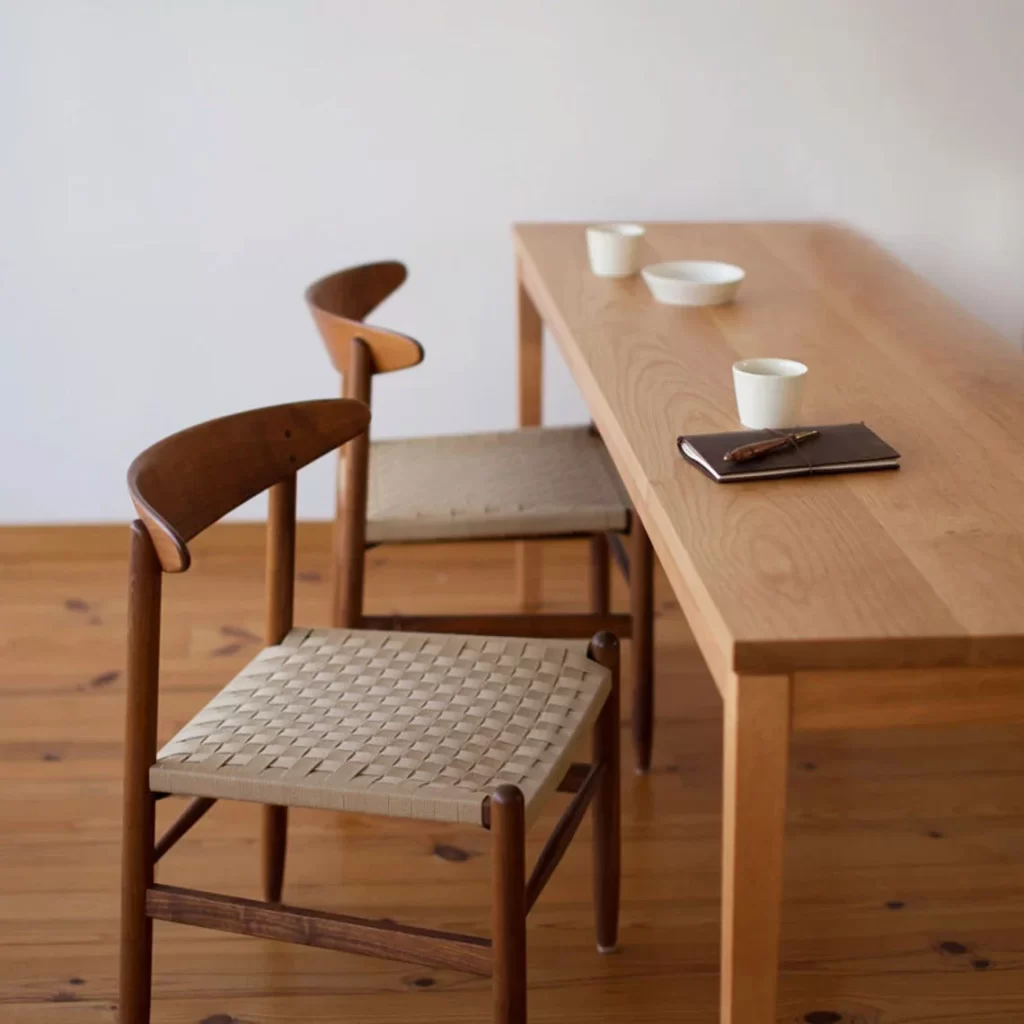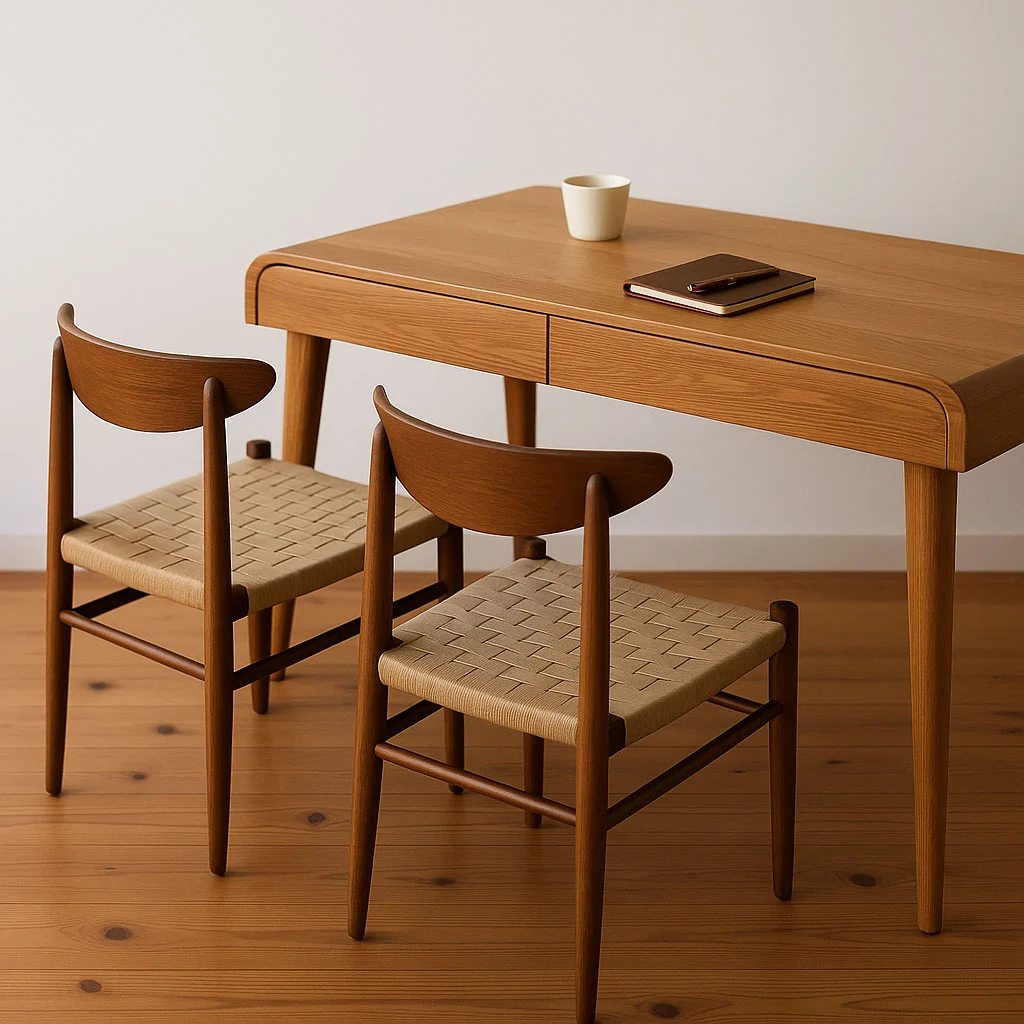
Stress has become a constant companion in our modern lives. Our bodies respond to this stress by producing cortisol, a hormone that, while necessary for survival, can harm our health when chronically elevated. What if the solution to lowering your stress levels was as simple as changing your surroundings? Let’s look at which interior wood elements are most effective at reducing your cortisol levels.
What Makes Wood Special for Stress Reduction?
Wood isn’t just aesthetically pleasing—it has genuine stress-reducing properties. Our innate connection to nature, known as biophilia, means we respond positively to natural materials in our environment.
Research shows that exposure to wood correlates with decreased cortisol levels, lower blood pressure, and reduced heart rate compared to environments without wood. This aligns with the understanding that wood has stress-reducing effects similar to nature exposure.
Most Effective Wood Elements for Cortisol Reduction

1. Oak Wood Furniture
In a comparative study between oak and walnut furniture in office-like settings, oak furniture demonstrated superior stress-reducing properties. Participants in the oak-furnished environment had 13.6% lower cortisol concentrations than those in the control room without wood.
Rustic Oak End Table [click to view…]
Interestingly, walnut furniture didn’t show the same significant benefits. Researchers suggest oak’s lighter color may create a brighter environment, contributing to its effectiveness.
2. Solid Wood Construction Elements
A study in Austrian classrooms compared spaces with solid wood walls, floors, and ceilings to traditional classrooms with linoleum floors and plasterboard walls. Students in solid wood classrooms had significantly lower heart rates—about six beats per minute less—and reported lower perceived stress levels.
This research suggests that surrounding yourself with solid wood structural elements may be even more effective than simply adding wood furniture.
3. Pine Wood Elements
Pine trees contain compounds called phytoncides, essential oils that have been found to decrease cortisol levels. These natural substances are released from pine wood even after harvesting, contributing to stress reduction through olfactory pathways.
The Sensory Experience of Wood
Visual Impact

Wood with visible grain is particularly powerful as a de-stressor. Research indicates there may be an optimal amount of wood in a room—approximately 45% surface coverage appears most effective for stress reduction. Beyond this level, additional wood doesn’t provide significantly more benefits.
A study examining visual stimulation using images of Japanese cedar wood found that both knotty and clear wood promoted comfort and relaxation, though clear wood produced more positive subjective experiences.
Tactile Benefits
The physical sensation of touching wood also matters. Research shows that touching white oak decreased oxy-Hb concentration in the prefrontal cortex and increased parasympathetic nervous activity—both indicators of relaxation. Natural and smooth wood surfaces are perceived more positively during emotional touch compared to coated surfaces, with the most positive responses coming from surfaces where the natural texture was fully preserved.
Olfactory Effects
The natural scent of wood contributes significantly to stress reduction. Our sense of smell has direct pathways to the brain’s memory and emotional centers, allowing wood scents to trigger strong emotional responses almost instantly. Certain wood scents have therapeutic properties used in aromatherapy to promote relaxation.
The volatile organic compounds (VOCs) emitted by wood, particularly terpenes, interact with our olfactory system to potentially influence stress levels.
Wood in Different Settings
Offices
Oak desk with drawers [click to view…]
Increasing wood surfaces in office environments correlates with measurable reductions in stress indicators including blood pressure and heart rate. Research involving hair cortisol testing among tradespeople working in timber spaces suggested a decrease in long-term cortisol levels.
Oak furniture appears to be particularly effective in workplace settings.
Schools
Studies show that teachers and students in wood buildings report less fatigue, and students perceive schools with more wooden interiors as brighter. In Austrian schools, interior wood use reduced pupils’ stress levels, as indicated by heart rate measurements and perceived stress from interaction with teachers.
Healthcare Facilities
Biophilic design principles, including the use of exposed wood, have been shown to improve recovery rates, reduce patient stress, and potentially shorten hospital stays. A study at the National Oncology Institute in Slovakia found that patients in a wooden waiting room experienced a 7.5% decrease in cortisol levels, demonstrating wood’s stress-reducing capabilities in healthcare settings.
Optimal Guidelines for Using Wood to Reduce Stress
handmade Custom Work Desk [click to view…]
Based on the research, here are the most effective ways to incorporate wood for cortisol reduction:
- Choose oak over other woods for furniture, particularly in work environments
- Aim for solid wood construction elements where possible (floors, walls, ceilings)
- Keep wood finishes natural to preserve tactile benefits
- Ensure wood grain is visible for maximum visual de-stressing effects
- Consider pine elements for their beneficial phytoncides
- Aim for about 45% wood coverage in a room for optimal effects
- Use clear rather than knotty wood for slightly better subjective experiences
Important Considerations
While wood offers stress-reducing benefits, it’s important to consider indoor air quality. Wood emits various organic substances, including VOCs, which vary by wood species, treatments, and environmental conditions. When incorporating wood, select products with low-VOC or zero-VOC finishes, and ensure adequate ventilation.
Conclusion
The research clearly shows that not all wood elements are created equal when it comes to reducing cortisol levels. Oak furniture, solid wood construction elements, and pine woods appear to offer the most significant benefits for stress reduction.
By strategically incorporating these specific wood elements into your home, office, or other spaces, you can create environments that actively work to reduce your body’s stress response, potentially leading to improved health, well-being, and quality of life.
Remember that the most effective approach combines multiple sensory experiences—visual exposure to wood grain, tactile interaction with natural wood surfaces, and olfactory exposure to wood scents—to maximize the stress-reducing benefits of this remarkable natural material.
Dora Decora is a biophilic interior design specialist and passionate blogger. With a deep commitment to integrating nature into living spaces, Dora specializes in creating environments that foster human-nature connections through thoughtful design elements. Her approach emphasizes sustainable materials, natural lighting, and organic patterns that enhance wellbeing and reduce environmental impact.
This post (https://homechroma.com/interior-wood-elements-reduce-cortisol) was originally published by Dora Decora on Home Chroma. As an Amazon Associates partner, we are compensated for all qualifying purchases.































